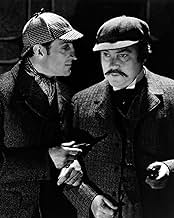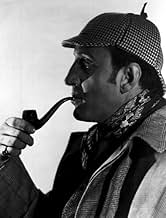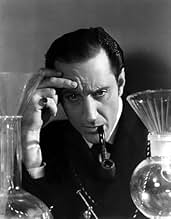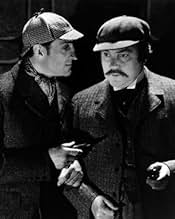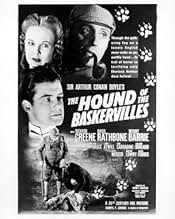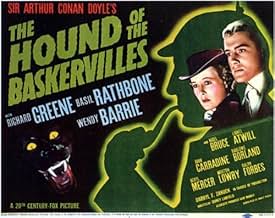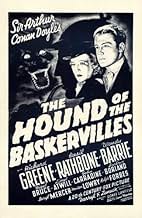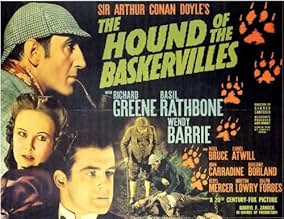IMDb रेटिंग
7.4/10
12 हज़ार
आपकी रेटिंग
शेरलॉक होम्स और डॉ वाटसन एक अलौकिक शिकारी कुत्ते की कहानी की जांच करते हैं, एक जानवर जो कोहरे से घिरे दलदल पर एक युवा वारिस को घूर सकता है जो अपनी संपत्ति बनाता है.शेरलॉक होम्स और डॉ वाटसन एक अलौकिक शिकारी कुत्ते की कहानी की जांच करते हैं, एक जानवर जो कोहरे से घिरे दलदल पर एक युवा वारिस को घूर सकता है जो अपनी संपत्ति बनाता है.शेरलॉक होम्स और डॉ वाटसन एक अलौकिक शिकारी कुत्ते की कहानी की जांच करते हैं, एक जानवर जो कोहरे से घिरे दलदल पर एक युवा वारिस को घूर सकता है जो अपनी संपत्ति बनाता है.
- निर्देशक
- लेखक
- स्टार
- पुरस्कार
- कुल 1 जीत
Nigel De Brulier
- Convict
- (as Nigel de Brulier)
Ian Maclaren
- Sir Charles
- (as Ian MacLaren)
Brandon Beach
- Ship Passenger
- (बिना क्रेडिट के)
Leonard Carey
- Hugo's Servant
- (बिना क्रेडिट के)
फ़ीचर्ड समीक्षाएं
Of the half dozen or so different takes on The Hound of the Baskervilles that I've seen, this one is my favorite - just barely edging out the Hammer film from 1959. Why? There are a number of reasons I could cite.
1. Acting - The 1939 version of the Hound of the Baskervilles has to have one of the strongest casts ever assembled for a Sherlock Holmes film. It's a veritable Who's Who of 1930s/40s horror/thriller stars. Basil Rathbone, Lionel Atwill, John Carradine, Wendy Barrie, and Eily Malyon all give outstanding performances. Even E.E. Clive appears in a small but enjoyable role. And Nigel Bruce, whose bumbling Watson could really get on my nerves, gives one of his best performances as Holmes' sidekick.
2. Atmosphere - If there's something that filmmakers from the 1930s knew how to do and were especially adept at, its creating atmosphere. From the fog shrouded moors to the dangerous London streets, there's enough atmosphere in The Hound of the Baskervilles for two or three movies. The cinematography and lighting go along way to helping create this feeling. It's something that seems lost on many of today's filmmakers.
3. Direction - While nothing outstanding, Sidney Lanfield is nonetheless solid in the director's chair. One key is the pacing he gives to the film. The movie moves along quite nicely with very few moments that slow things down. Sure, this version of The Hound of the Baskervilles may veer away from the original source material, but it's for good reason. The film would have been too slow and, ultimately, quite dull had it stuck too closely to Sir Arthur Conan Doyle's work. I've read the book, but as much as I enjoy it, I realize changes have to be made for the screen.
While there are a number of other things I could mention in The Hound of the Baskervilles that appeal to me, I'll stop here before this thing gets out of hand. In the end, I've always found this a solid production and a very enjoyable film. I've got no problems rating it a 9/10.
Finally, one thing that has always seemed odd to me is the appeal of The Hound of the Baskervilles. Don't misunderstand, it's a good story. But I'm not sure I understand why it has been filmed more often than any other Sherlock Holmes story. Why would a plot that has its main character (Holmes in this case) disappear for about half the movie be the most famous and most often filmed story from the character's casebook? Like I said, it's just always seemed a bit odd to me.
1. Acting - The 1939 version of the Hound of the Baskervilles has to have one of the strongest casts ever assembled for a Sherlock Holmes film. It's a veritable Who's Who of 1930s/40s horror/thriller stars. Basil Rathbone, Lionel Atwill, John Carradine, Wendy Barrie, and Eily Malyon all give outstanding performances. Even E.E. Clive appears in a small but enjoyable role. And Nigel Bruce, whose bumbling Watson could really get on my nerves, gives one of his best performances as Holmes' sidekick.
2. Atmosphere - If there's something that filmmakers from the 1930s knew how to do and were especially adept at, its creating atmosphere. From the fog shrouded moors to the dangerous London streets, there's enough atmosphere in The Hound of the Baskervilles for two or three movies. The cinematography and lighting go along way to helping create this feeling. It's something that seems lost on many of today's filmmakers.
3. Direction - While nothing outstanding, Sidney Lanfield is nonetheless solid in the director's chair. One key is the pacing he gives to the film. The movie moves along quite nicely with very few moments that slow things down. Sure, this version of The Hound of the Baskervilles may veer away from the original source material, but it's for good reason. The film would have been too slow and, ultimately, quite dull had it stuck too closely to Sir Arthur Conan Doyle's work. I've read the book, but as much as I enjoy it, I realize changes have to be made for the screen.
While there are a number of other things I could mention in The Hound of the Baskervilles that appeal to me, I'll stop here before this thing gets out of hand. In the end, I've always found this a solid production and a very enjoyable film. I've got no problems rating it a 9/10.
Finally, one thing that has always seemed odd to me is the appeal of The Hound of the Baskervilles. Don't misunderstand, it's a good story. But I'm not sure I understand why it has been filmed more often than any other Sherlock Holmes story. Why would a plot that has its main character (Holmes in this case) disappear for about half the movie be the most famous and most often filmed story from the character's casebook? Like I said, it's just always seemed a bit odd to me.
I am a huge fan of all the Rathbone/Bruce movies, but this is the best of them all. The atmosphere and lighting casts the perfect mood for the dark, creepy moor where strange goings on interest Holmes and Watson to help the young heir of Baskerville Hall. All the actors do an excellent job, and the movie, filmed some 60 years go does not seem dated. The writing, directing, acting, etc all stand up, even now, some years later. I also liked the 1959 Hammer Version of this story, but Peter Cushing is not the perfect Sherlock Holmes. Basil Rathbone is the definitive Holmes as Nigel Bruce is the perfect Dr. Watson. Watch this sometime soon and enjoy!!!
This classic take on Arthur Conan Doyle's classic novel is a fantastic thriller. Although I prefer the Hammer Horror version, this one is a more than worthy second. The story will be familiar to most people that know anything about classic literature, and it features a family that have been cursed by a mythical hound, due to an ancestor's actions years earlier. After the death of his uncle, Sir Henry Baskerville moves into Baskerville Hall, which is located on the Moors in Dartford, and claims his family fortune. However, the hound may still be a large and Sir Henry's life may be at stake. Enter ace detective Sherlock Holmes. Hired by the doctor and friend of the family, Sherlock sends his assistant, Dr Watson, down to Dartmoor to investigate the goings on down there while he attends to some other business back in London. What follows is an exceptional exhibition of atmosphere, mystery and tension as the enigma of the hound of the Baskervilles unfolds in front of the audience's eyes!
The Moors serve as an excellent setting for a story like this. As the film is keen to profess, it's location is as rich in life as the story itself and that's what makes the Moors all important for the film's story. The Moors are also extremely atmospheric, with it's many pitfalls creating a foreboding atmosphere and the smoke that protrudes from it's many pores helping to make the horror elements more potent within the story. Sherlock Holmes is, of course, one of the best and most important characters ever written and Basil Rathbone portrays him excellently in this film. It's a great honour for an actor to be given the role of this magnitude, and Rathbone makes Doyle proud. The story is constantly intriguing thanks to the interesting characters, and also due to the fact that the story is very well paced. This makes the film a pleasure to view, as the audience is constantly kept on the edge of their seats for the duration, and that's the sort of reaction that you want when watching a mystery thriller.
The Moors serve as an excellent setting for a story like this. As the film is keen to profess, it's location is as rich in life as the story itself and that's what makes the Moors all important for the film's story. The Moors are also extremely atmospheric, with it's many pitfalls creating a foreboding atmosphere and the smoke that protrudes from it's many pores helping to make the horror elements more potent within the story. Sherlock Holmes is, of course, one of the best and most important characters ever written and Basil Rathbone portrays him excellently in this film. It's a great honour for an actor to be given the role of this magnitude, and Rathbone makes Doyle proud. The story is constantly intriguing thanks to the interesting characters, and also due to the fact that the story is very well paced. This makes the film a pleasure to view, as the audience is constantly kept on the edge of their seats for the duration, and that's the sort of reaction that you want when watching a mystery thriller.
"The Hound of the Baskervilles" was the first movie that paired the great actor Basil Rathbone as Sherlock Holmes and Nigel Bruce as his bumbling yet lovable assistant, Dr. Watson. The two actors embody the characters of Holmes and Watson, and it's a delight to see the interaction between the two. This movie is great on all levels, from the creepy atmosphere of the moors where the "hound from hell" roams, to the performances of all the actors involved. Richard Greene, who plays Sir Henry Baskerville, and John Carradine also give solid performances. I remember watching this movie on late night TV with my sister when I was a kid and being genuinely frightened by the scenes on the moor when Richard Greene is being chased by the hound. For me this is the best of the Sherlock Holmes series of movies that was made in the late 1930's and 1940's. A must see!
As a Sherlock Holmes enthusiast, I'd LOVE a 100% faithful adaptation of THE HOUND OF THE BASKERVILLES; but as a realist, I know that the only way that would happen is if a group of actors read the book word for word on radio or audiotape. After all, what works in a book doesn't always work on screen; and Ernest Pascal's adaptation is faithful to the spirit, if not always the letter, of Conan Doyle's novel (just watch the scene in the hut on the moor when Watson meets up with Holmes, who explains what's going on: 'Murder, my dear Watson. Refined, cold-blooded murder.' The scene as written by Conan Doyle is a bit dry; Pascal expands on it in a way that makes the scene work on film, and in doing so shows that he was clearly in tune with the source material. Yes, some key characters were dropped or had their parts reduced; others were built up so there would be a few more suspects. In the end, however, we're left with what is still the best version of HOUND ever committed to celluloid. Basil Rathbone IS Holmes: even if he had never played the character again, he would still be guaranteed a place among the great portrayers of the detective. Nigel Bruce's Watson is brave and loyal, and not the somewhat bumbling sidekick he became in the later films; and there is a real friendship between his Watson and Rathbone's Holmes which is a crucial element of any portrayal of the characters, yet which is so often missing. As is only natural with a film made more than sixty years ago, it does creak a bit in places; but it's still a wonderful way to spend ninety or so minutes.
क्या आपको पता है
- ट्रिवियाIn the original novel, and in all later film versions, the butler is named Barrymore. In this version, the butler was renamed Barryman since the famous Barrymore family - Lionel Barrymore, Ethel Barrymore and John Barrymore - were still acting in films at the time.
- गूफ़The Baskerville and Stapleton houses on Dartmoor appear to be lit by gas. At that time, gas was available only in proximity to a gas works and thus only in towns: it was known as "town gas". So people living in remote mansions would have had to rely on candles and oil lamps.
- भाव
[last lines]
Sherlock Holmes: Oh, Watson... the needle.
- कनेक्शनEdited into Cynful Movies: The Hound of the Baskervilles (2019)
टॉप पसंद
रेटिंग देने के लिए साइन-इन करें और वैयक्तिकृत सुझावों के लिए वॉचलिस्ट करें
विवरण
- रिलीज़ की तारीख़
- कंट्री ऑफ़ ओरिजिन
- भाषा
- इस रूप में भी जाना जाता है
- Baskervilski pas
- फ़िल्माने की जगहें
- उत्पादन कंपनी
- IMDbPro पर और कंपनी क्रेडिट देखें
- चलने की अवधि1 घंटा 20 मिनट
- रंग
- पक्ष अनुपात
- 1.37 : 1
इस पेज में योगदान दें
किसी बदलाव का सुझाव दें या अनुपलब्ध कॉन्टेंट जोड़ें

टॉप गैप
By what name was The Hound of the Baskervilles (1939) officially released in Canada in French?
जवाब
